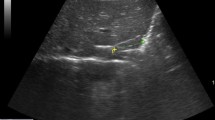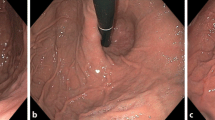Abstract
Sonography appears highly sensitive in characterizing the severity of gastroesophageal reflux, screening the infants at risk of esophagitis. Sonography is also useful in evaluating efficacy of treatment. In our experience reflux is only damaging if constantly repeated and related to severe hiatal dysfunction. Ultrasound (US) is a good alternative for the assessment of hiatal function and gives furthermore indispensable morphological data.
Similar content being viewed by others
References
Meyers WF, Roberts CC, Johnson DG, Herbst JJ (1985) Value of tests for evaluation of gastroesophageal reflux in children. J Pediatr Surg 20:515
Naik DR, Moore DJ (1984) Ultrasound diagnosis of gastroesophageal reflux. Arch Dis Child 59:366
Wright LL, Baker KR, Meny RG (1988) Ultrasound demonstration of gastroesophageal reflux. J Ultrasound Med 7:471
Mallet E, Le Dosseur P (1989) La place de l'échographie dans le reflux gastro-oesophagien. Radiopédiatrie 1989. Sauramps Medical Montpellier, p 75
Le Dosseur P, Beaudet S, Oarda M, Mouterde O, Mallet E, Eurin D (1989) Gastro-esophageal reflux in infants: result of standardized US study. ESPR, 26th Congress, Dublin, 25th May 1989, n° 27
Pracros JP, Bresson E, Morin de Finfe CH, Tran-Minh VA (1989) Echographie de la jonction oesogastrique chez l'enfant: aspects normaux et pathologiques. Radiologie J Cepur 9:227
Cargill G (1990) Intérêt de la manométrie et de la pHmétri oesophagienn dans le reflux. Congrès du GREEFDE sur le reflux gastro-oesophagien, Reims, 4 Mai 1990, p 33
Hillemeier AC, Lange R, McCallum R, Seashore J, Gryboski J (1981) Delayed gastric empting in infants with gastroesophageal reflux. J Pediatr 98:190
Strobel CT, Byrne WJ, Ament ME (1979) Corrlation of esophageal lengths in children with height: application to the tuttle test without prior esophageal monometry. J Pediatr 94:81
Boix-Ochoa J, Canals J (1976) Maturation of the lower esophagus. J Pediatr Surg 11:749
De Meester TR, Johnson LF (1976) The evaluation of objective measurement of gastroesophageal reflux and their contribution to patient management. Surg Clin North An 56:39
Boix-Ochoa J, Lafuente JM, Gil-Vernet JM (1980) Twenty four hour esophageal pH monitoring in gastroesophageal reflux. J Pediatr Surg 15:74
Sondheimer JM (1980) Continous monitoring of distal esophageal pH: A diagnostic test for gastroesophageal reflux in infants. J Pediatr 96:804.
Euler AR, Byrne WJ (1981) Twenty four hour esophageal intraluminal pH probe testing: a comparative analysis. Gastroenterology 80:957
Couturier D, Roze C, Vasconcellos D, Accary JP, Debray C (1973) The effects of acid in stomach and duodenum upon the gastric myoelectrical activity in man. Digestion 9:502
Author information
Authors and Affiliations
Rights and permissions
About this article
Cite this article
Gomes, H., Menanteau, B. Gastro-esophageal reflux: Comparative study between sonography and pH monitoring. Pediatr Radiol 21, 168–174 (1991). https://doi.org/10.1007/BF02011038
Issue Date:
DOI: https://doi.org/10.1007/BF02011038




